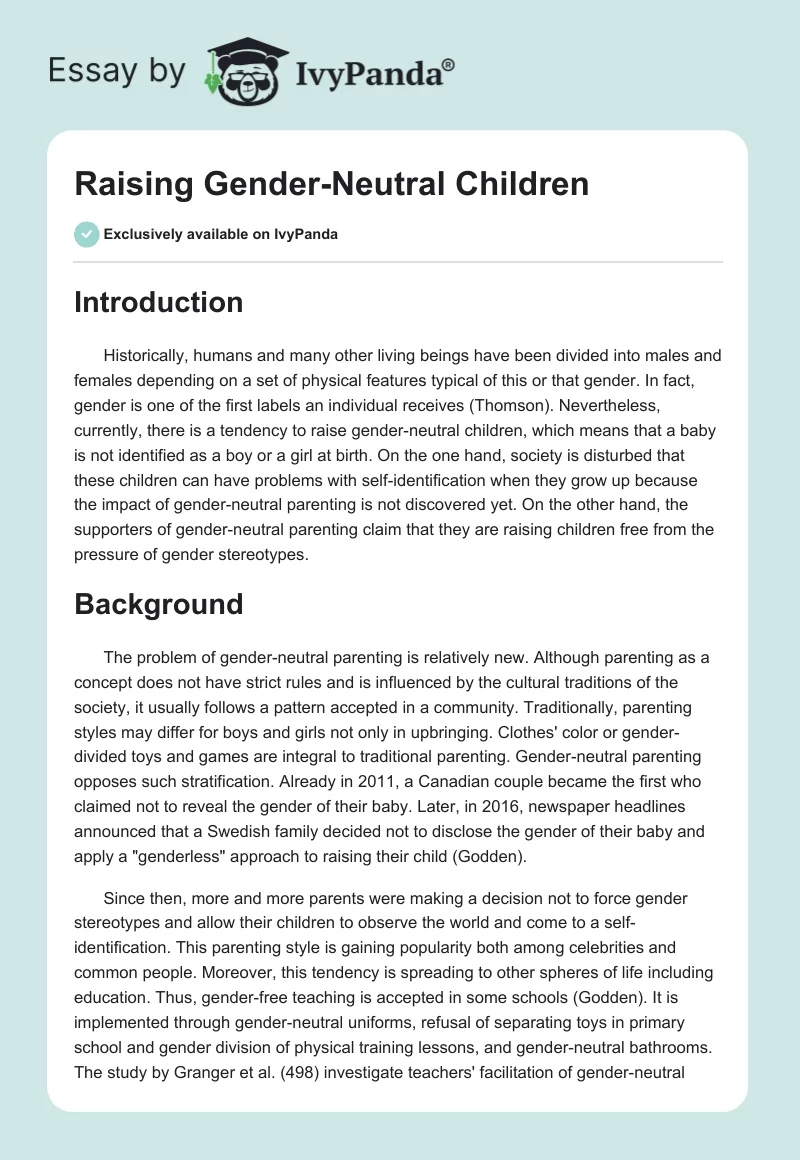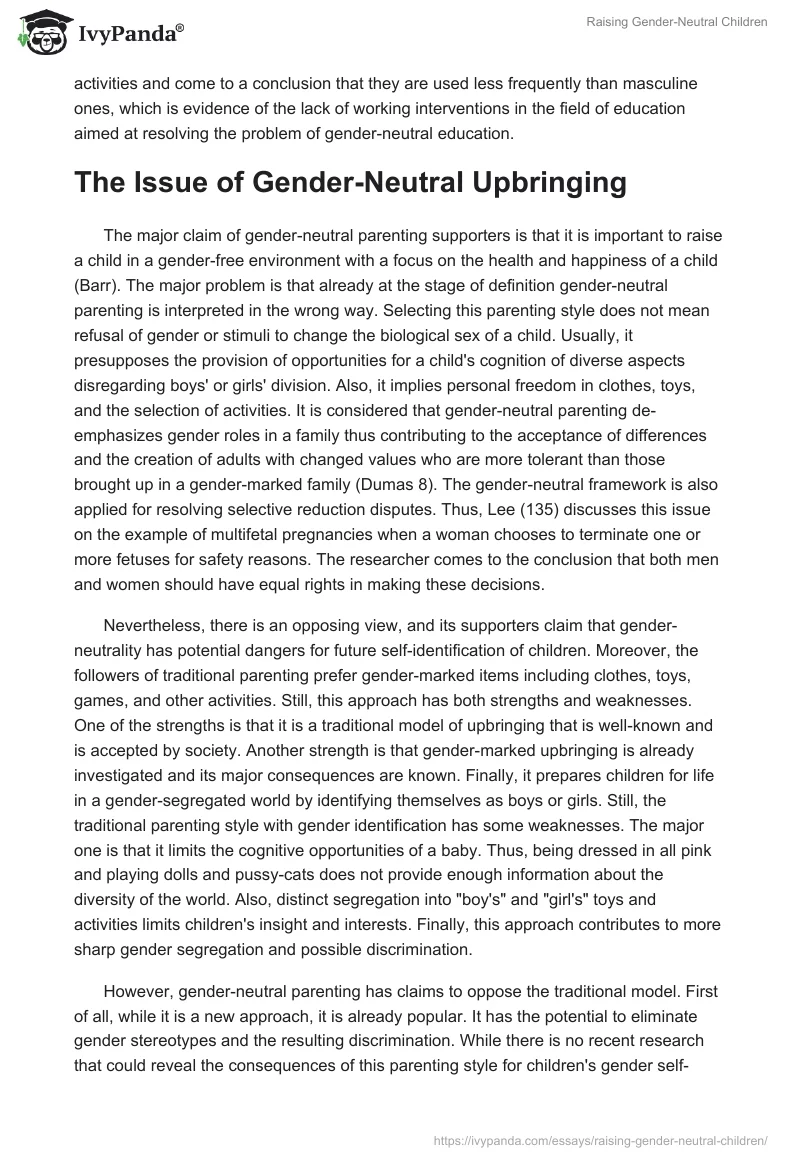Introduction
Historically, humans and many other living beings have been divided into males and females depending on a set of physical features typical of this or that gender. In fact, gender is one of the first labels an individual receives (Thomson). Nevertheless, currently, there is a tendency to raise gender-neutral children, which means that a baby is not identified as a boy or a girl at birth. On the one hand, society is disturbed that these children can have problems with self-identification when they grow up because the impact of gender-neutral parenting is not discovered yet. On the other hand, the supporters of gender-neutral parenting claim that they are raising children free from the pressure of gender stereotypes.
Background
The problem of gender-neutral parenting is relatively new. Although parenting as a concept does not have strict rules and is influenced by the cultural traditions of the society, it usually follows a pattern accepted in a community. Traditionally, parenting styles may differ for boys and girls not only in upbringing. Clothes’ color or gender-divided toys and games are integral to traditional parenting. Gender-neutral parenting opposes such stratification. Already in 2011, a Canadian couple became the first who claimed not to reveal the gender of their baby. Later, in 2016, newspaper headlines announced that a Swedish family decided not to disclose the gender of their baby and apply a “genderless” approach to raising their child (Godden).
Since then, more and more parents were making a decision not to force gender stereotypes and allow their children to observe the world and come to a self-identification. This parenting style is gaining popularity both among celebrities and common people. Moreover, this tendency is spreading to other spheres of life including education. Thus, gender-free teaching is accepted in some schools (Godden). It is implemented through gender-neutral uniforms, refusal of separating toys in primary school and gender division of physical training lessons, and gender-neutral bathrooms. The study by Granger et al. (498) investigate teachers’ facilitation of gender-neutral activities and come to a conclusion that they are used less frequently than masculine ones, which is evidence of the lack of working interventions in the field of education aimed at resolving the problem of gender-neutral education.
The Issue of Gender-Neutral Upbringing
The major claim of gender-neutral parenting supporters is that it is important to raise a child in a gender-free environment with a focus on the health and happiness of a child (Barr). The major problem is that already at the stage of definition gender-neutral parenting is interpreted in the wrong way. Selecting this parenting style does not mean refusal of gender or stimuli to change the biological sex of a child. Usually, it presupposes the provision of opportunities for a child’s cognition of diverse aspects disregarding boys’ or girls’ division. Also, it implies personal freedom in clothes, toys, and the selection of activities. It is considered that gender-neutral parenting de-emphasizes gender roles in a family thus contributing to the acceptance of differences and the creation of adults with changed values who are more tolerant than those brought up in a gender-marked family (Dumas 8). The gender-neutral framework is also applied for resolving selective reduction disputes. Thus, Lee (135) discusses this issue on the example of multifetal pregnancies when a woman chooses to terminate one or more fetuses for safety reasons. The researcher comes to the conclusion that both men and women should have equal rights in making these decisions.
Nevertheless, there is an opposing view, and its supporters claim that gender-neutrality has potential dangers for future self-identification of children. Moreover, the followers of traditional parenting prefer gender-marked items including clothes, toys, games, and other activities. Still, this approach has both strengths and weaknesses. One of the strengths is that it is a traditional model of upbringing that is well-known and is accepted by society. Another strength is that gender-marked upbringing is already investigated and its major consequences are known. Finally, it prepares children for life in a gender-segregated world by identifying themselves as boys or girls. Still, the traditional parenting style with gender identification has some weaknesses. The major one is that it limits the cognitive opportunities of a baby. Thus, being dressed in all pink and playing dolls and pussy-cats does not provide enough information about the diversity of the world. Also, distinct segregation into “boy’s” and “girl’s” toys and activities limits children’s insight and interests. Finally, this approach contributes to more sharp gender segregation and possible discrimination.
However, gender-neutral parenting has claims to oppose the traditional model. First of all, while it is a new approach, it is already popular. It has the potential to eliminate gender stereotypes and the resulting discrimination. While there is no recent research that could reveal the consequences of this parenting style for children’s gender self-identification, the real-life cases published in newspapers and magazines provide evidence that the majority of gender-free children identify themselves in accordance with their biological sex (Barr; Godden; Wells). Moreover, most of the parents supporting gender-neutral upbringing do not intend to conform to a “binary gender” but to provide broader opportunities for their children (Ritschel). Thus, gender-neutral parenting is more allowing than restricting the activities the children can and want to participate in providing them with opportunities to try different tasks and select some that a child is eager to continue.
Conclusion
To summarizing, it should be mentioned that a gender-neutral approach can be beneficial not only for babies during their first years of life. In a more global context, it has the potential to reduce sexism in the world. Also, playing with toys teaches some skills. Therefore, it is evident that the more diverse the toys are, the more skills a child will possess. Moreover, no focus on gender-specific games stimulates children to play together with different types of games thus enhancing their communicative ability and providing grounds for future self-identification. On the whole, gender-neutral parenting has the potential to reduce gender-related discriminative issues and contribute to the development of diverse skills and competencies due to the involvement in different activities.
Works Cited
Barr, Sabrina. “Mother Reveals Why She’s Raising Her Child ‘Gender Neutral.’”Independent. 2018, Web.
Godden, Maryse. “Gender Issue: What Is Gender-Neutral Parenting and Gender-Free Teaching for Kids? New Trends Explained.”The Sun, 2018, Web.
Granger, Kristen et al. “Preschool Teachers’ Facilitation of Gender-Typed and Gender-Neutral Activities during Free Play.” Sex Roles, vol. 76, 2017, pp. 498-510.
Lee, Kathleen. “In Support of Gender-Neutral Framework for Resolving Selective Reduction Disputes.” Family Law Quarterly, vol. 44, no. 1, 2010, pp. 135-153.
Dumas, Moria Duffy. Gender Neutral Parenting: An Argument for a Place on the Contemporary Feminist Agenda. Dissertation, Southern Connecticut State University. 2015, SCSU, 2015.
Ritschel, Chelsea. “Couple Raises Child as a Gender-Neutral ‘They-By.’”Independent. 2018, Web.
Thomson, Helen. “10 Science-Backed Tips for Bringing up Your Child Gender Neutral.”Forbes Magazine. 2017, Web.
Wells, Ashlee Dean. “I’m Raising My Child Gender-Free, and What I’ve Learned Is: It’s Not Enough.”Upworthy. 2018, Web.


